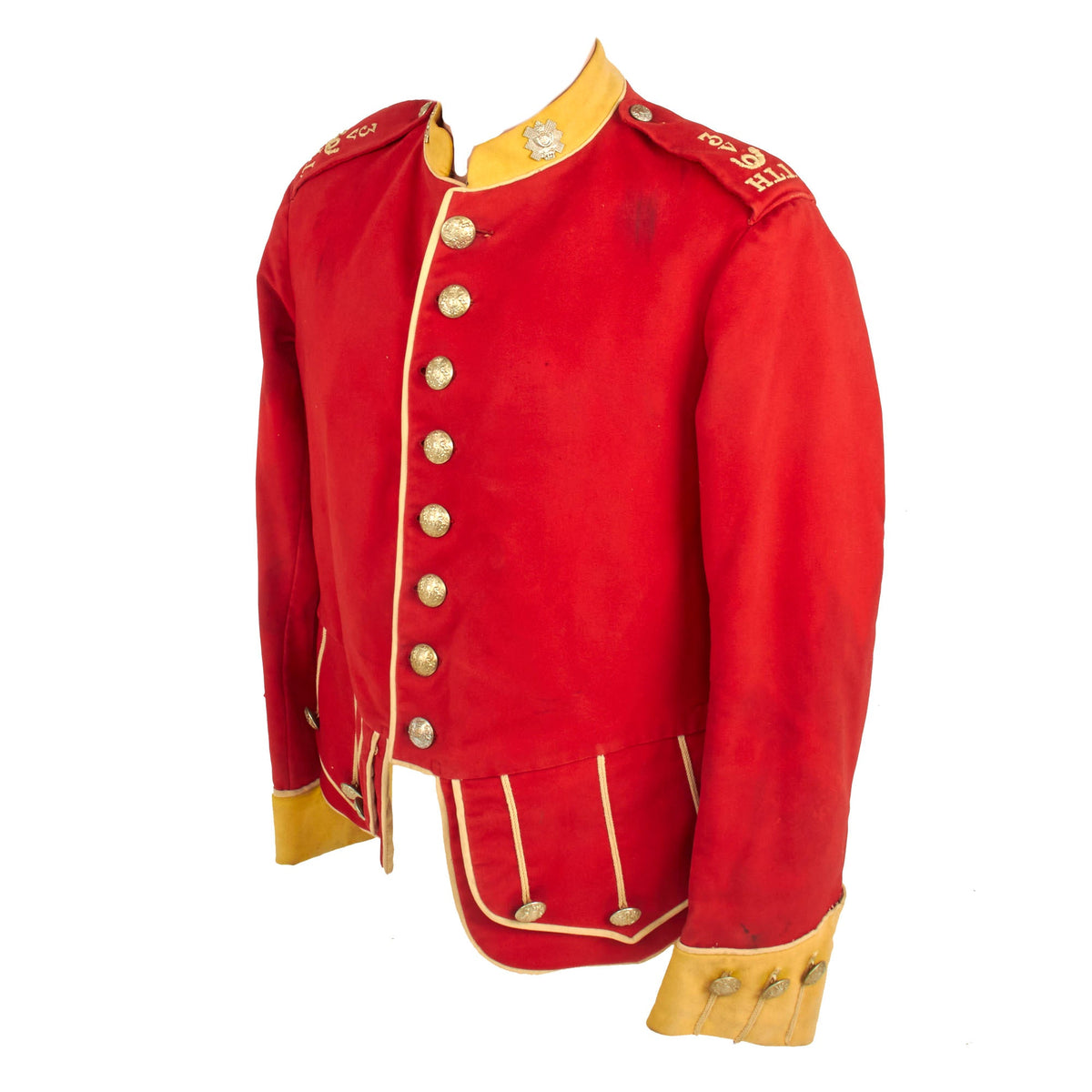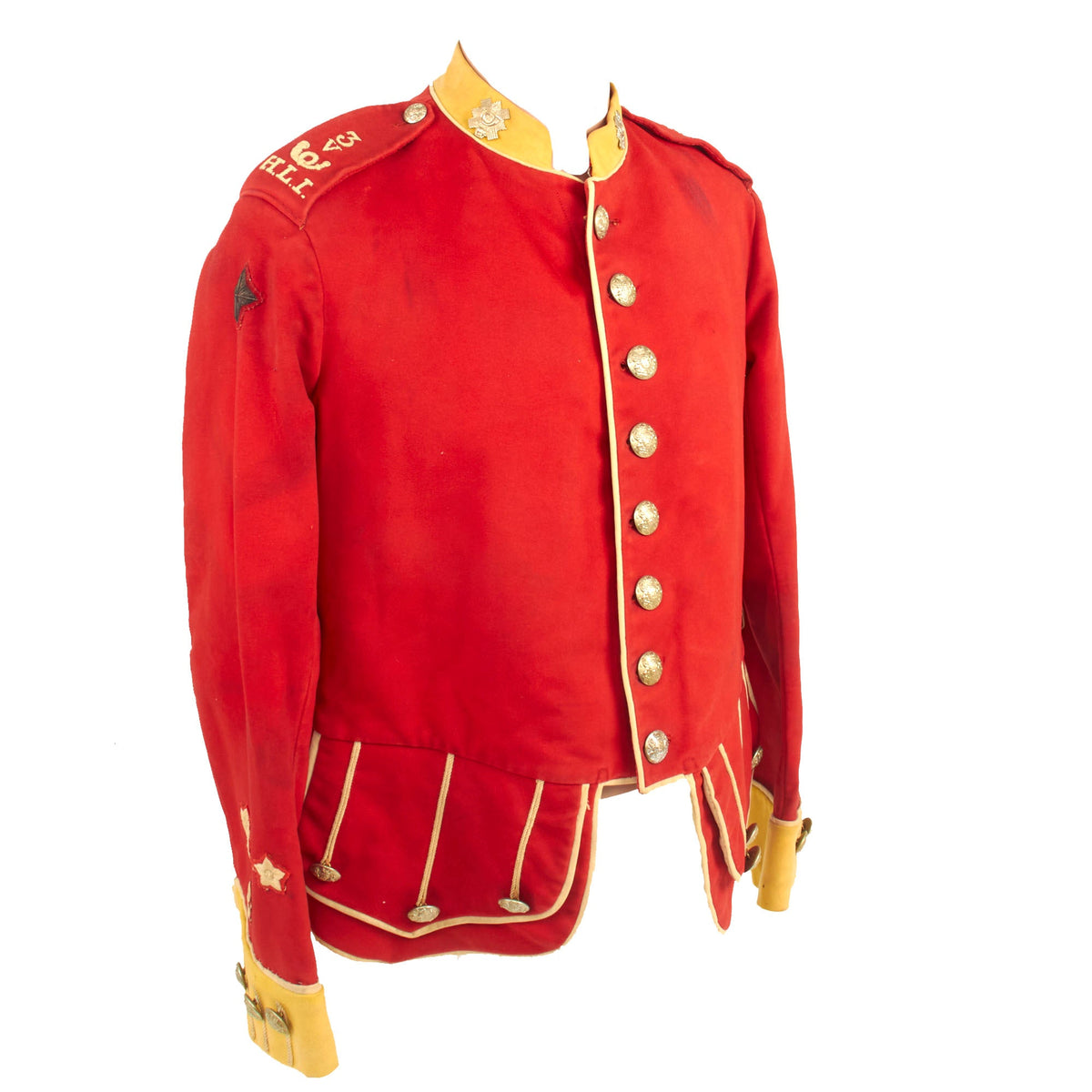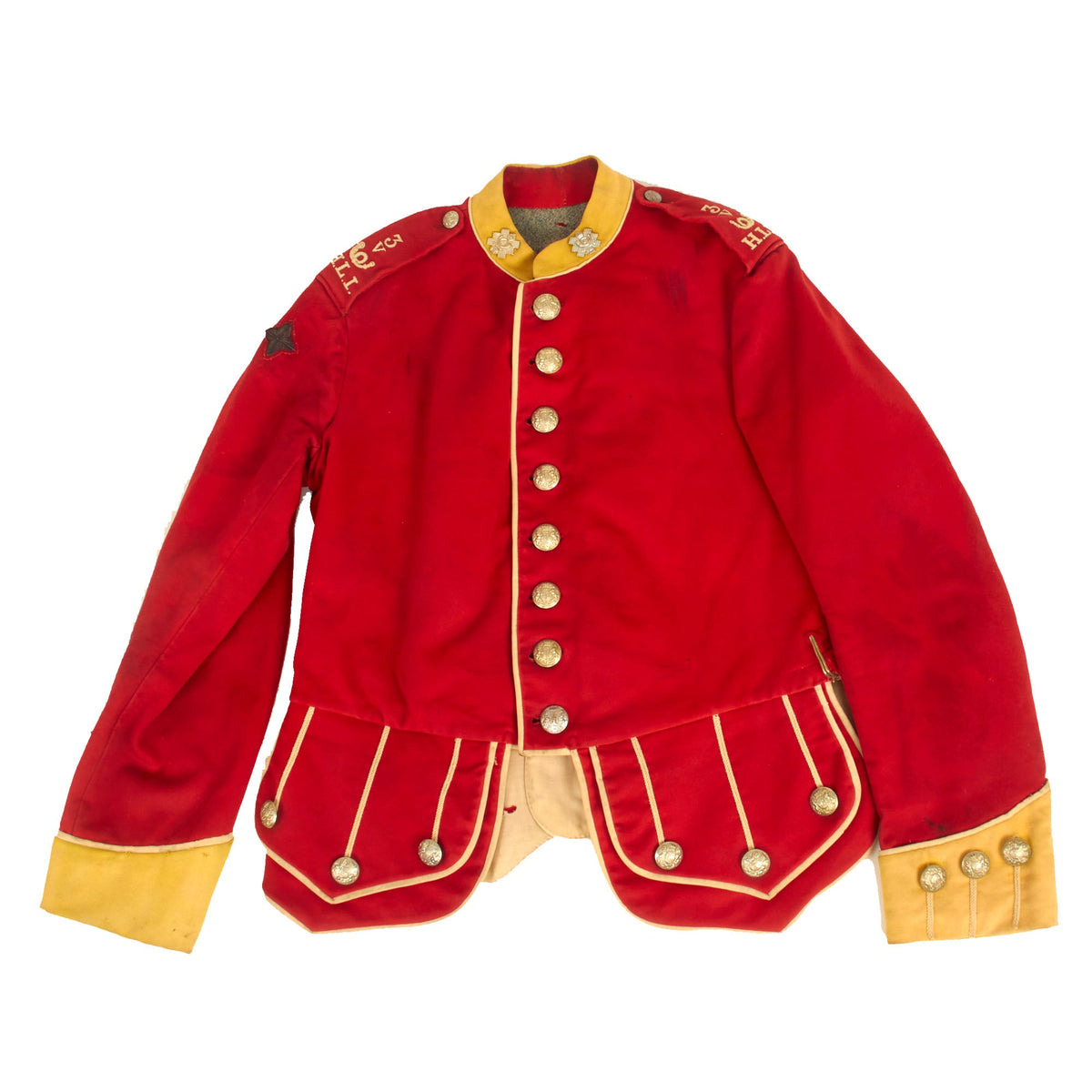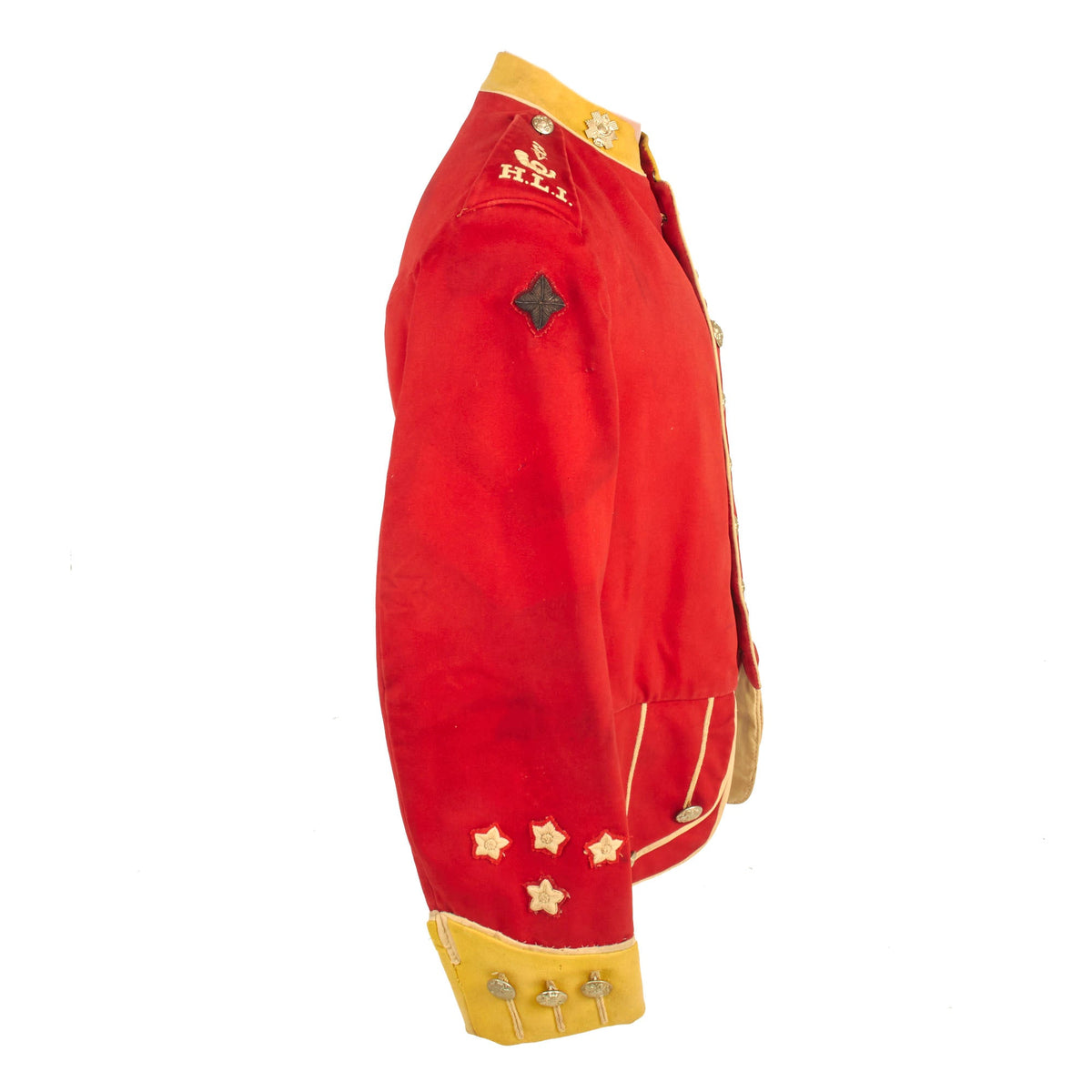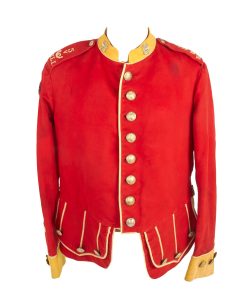Original British Pre-WWI Scottish 3rd (Blythswood) Volunteer Battalion, Highland Light Infantry Dress Doublet Original Items
$ 395,00 $ 118,50
Original Item: Only One Available. This is a very nice Pre-WWI era Royal Scots Doublet. This full dress uniform tunic has 8 gilt brass buttons with the Royal Scots coat of arms down the front. Other notable features are epaulets with embroidered insignia, stand up yellow collar with white piping. The interior is fully lined in a rather heavy cotton/wool material with remnants of a paper label.
A doublet is a man’s snug-fitting jacket that is shaped and fitted to the man’s body. The garment was worn in Spain, and spread to the rest of Western Europe, from the late Middle Ages up to the mid-17th century. The doublet was hip length or waist length and worn over the shirt or drawers. Until the end of the 15th century, the doublet was usually worn under another layer of clothing such as a gown, mantle, overtunic or jerkin when in public.
Throughout the 300 years of its use, the doublet served the same purpose: to give fashionable shape and padding to the body, to support the hose by providing ties, and to provide warmth to the body. The only things that changed about the doublet over its history was its style and cut, as you can see from this example here.
This doublet was worn by a member of the 3rd (Blythswood) Volunteer Battalion, Highland Light Infantry and is identified by the embroidered epaulets.
The uniform doublet is in overall wonderful condition but there are the expected scattered moth nips, slight thread separation and staining.
A great example that comes more than ready for further research and display.
The Blythswood Rifles was a Scottish Volunteer unit of the British Army. Raised in Glasgow from 1859, it later became a battalion of the Highland Light Infantry. During World War I it served at Gallipoli, in Egypt and Palestine, in Ireland, and on the Western Front. Converted into an anti-aircraft artillery regiment just before World War II, it served in The Blitz and in the Middle East during the war, and continued in the postwar Territorial Army until 1955.
An invasion scare in 1859 led to the emergence of the Volunteer Movement, and Rifle Volunteer Corps (RVCs) composed of part-time soldiers eager to supplement the Regular British Army in time of need began to be organized throughout Great Britain. The 2nd Administrative Battalion of Lanarkshire RVCs (shown in the Army List as the 4th Admin Bn until March 1861) was formed in Glasgow, Lanarkshire, on 4 July 1860 to administer 11 company-sized RVCs that had been raised in that city.
When the RVCs were consolidated in 1880, the battalion was renumbered as the 8th (Blythswood Rifles) Lanarkshire RVC. Under the ‘Localisation of Forces’ scheme introduced in 1872 by the Cardwell reforms, the 31st Lanarkshire RVC had been grouped with the 73rd (Perthshire) Regiment of Foot, the 90th Regiment of Foot (Perthshire Volunteers) and the 2nd Royal Lanark Militia in Brigade No 60. However, this affiliation was broken up in the Childers Reforms, under which the battalion became a volunteer battalion of the Highland Light Infantry (The Glasgow Regiment) (HLI) on 1 July 1881. It was formally redesignated as the 3rd (Blythswood) Volunteer Battalion, Highland Light Infantry in December 1887.
The Stanhope Memorandum of December 1888 introduced a Mobilization Scheme for Volunteer units, which would assemble in their own brigades at key points in case of war. In peacetime these brigades provided a structure for collective training. Under this scheme the Volunteer Battalions of the HLI were included in the Clyde Brigade, later the Glasgow Brigade based at Hamilton.
Lord Blythswood was succeeded as Lt-Col Commandant in 1897 by Colonel W. Clark, VD, who had been the unit’s second Lt-Col since 1877. Sixty-one volunteers from the battalion served alongside the Regulars in the Second Boer War, mostly in the 1st 2nd and 3rd Volunteer Service Companies of the HLI, earning the battalion its first Battle honor: South Africa 1900–02.
In 1902 the battalion built a new drill hall at 69 Main Street, Bridgeton, Glasgow, while musketry training was carried out at a 900 yards (820 m) range at Gilbertfield near Cambuslang. In the same year, the Volunteer Brigades were reorganized, and the HLI battalions split from the rest of the Glasgow units to form their own Highland Light Infantry Brigade, still based at Hamilton.
Approximate Measurements:
Collar to shoulder: 9.5″
Shoulder to sleeve: 26”
Shoulder to shoulder: 13.5”
Chest width: 20″
Waist width: 19″
Hip width: 19”
Front length: 27.5″
Fast Shipping with Professional Packaging
Thanks to our longstanding association with UPS FedEx DHL, and other major international carriers, we are able to provide a range of shipping options. Our warehouse staff is expertly trained and will wrap your products according to our exact and precise specifications. Prior to shipping, your goods will be thoroughly examined and securely secured. We ship to thousands clients each day across multiple countries. This shows how we're dedicated to be the largest retailer on the internet. Warehouses and distribution centres can be located throughout Europe as well as the USA.
Note: Orders with more than one item will be assigned a processing date depending on the item.
Before shipping before shipping, we'll conduct a thorough inspection of the items you have ordered. Today, the majority of orders will be delivered within 48 hours. The delivery time will be between 3-7 days.
Returns
The stock is dynamic and we cannot completely manage it because multiple stakeholders are involved, including our factory and warehouse. So the actual stock may alter at any time. It's possible that you may not receive your order once the order has been made.
Our policy is valid for a period of 30 days. If you don't receive the product within 30 days, we are not able to issue a refund or an exchange.
You can only return an item if it is unused and in the same state as the day you received it. You must have the item in its original packaging.
Related products
Uncategorized
Uncategorized
Armoured Fighting Vehicles of the World: AFVs of World War One (Hardcover Book) New Made Items
Uncategorized
Uncategorized
Uncategorized
Uncategorized
Armored Burgonet Helmet & Polearm from Scottish Castle Leith Hall Circa 1700 Original Items
Uncategorized
Uncategorized
Australian WWII Owen MK1 Machine Carbine SMG Custom Fabricated Replica with Sling Original Items
Uncategorized
Uncategorized
Uncategorized
Uncategorized
Uncategorized
Uncategorized
Uncategorized
Uncategorized
Uncategorized
Uncategorized
Angolan Rebel 1970s era 60mm Inert Display Mortar from Angolan Civil War Original Items

